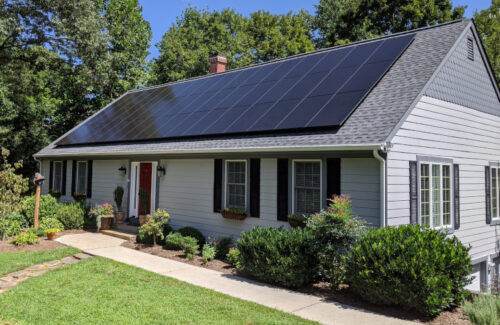
A residential solar + storage project completed by Virtue Solar in Virginia.
It’s not news to anyone in the industry that in order to grow solar in the United States, costs must come down. With the solar investment tax credit (ITC) going away, now is the time to utilize the tools currently available to reduce costs and continue to make an impact. At the SolarAPP Foundation, we’re committed to working with installers and local governments to cut permitting costs and timelines to provide affordable energy to homeowners. Our software, SolarAPP+ just surpassed 100,000 permits issued — a true testament to what can be done when all stakeholders come together to tackle a problem for our industry.
SolarAPP+ is an online software platform that automates the permitting process for residential solar and energy storage systems. Instead of waiting days, weeks or months for manual permit review, contractors using SolarAPP+ get instant same-day approvals for code-compliant solar and solar-plus-storage systems in participating jurisdictions. The platform ensures electrical code compliance, structural integrity and other safety standards are met, enabling cities and counties to dramatically reduce permitting backlogs and free up staff resources.
The National Renewable Energy Laboratory (NREL) developed SolarAPP+ in collaboration with solar industry stakeholders, code bodies, the building safety community and local governments to make it easier and faster for jurisdictions to issue compliant permits to licensed solar installers and contractors. SolarAPP+ is now managed by the non-profit SolarAPP Foundation, which I have the privilege of leading. Our aim is to lower the costs of the clean energy transition.
SolarAPP+ has been particularly successful in standardizing a highly fragmented and time-consuming permitting process across jurisdictions, lowering soft costs and accelerating solar deployment timelines.
 Expedited permitting for expanded impact
Expedited permitting for expanded impact
100,000 permits is more than a number — it represents a solar system that has been verified as code-compliant without requiring additional jurisdiction review, saving all parties time and money, while maintaining a high-quality bar for homeowners.
SolarAPP+ is available across over 300 jurisdictions in 17 states. The reach of SolarAPP+ is ever expanding, with new jurisdictions joining each week.
SolarAPP+ is poised to ensure that the number of expedited permitting continues to grow by:
- Keeping the platform free for jurisdictions
- Launching with new jurisdictions in as quick as 5 days
- Simplifying our tool for permit technicians and submitters
- Providing hands-on dedicated live support for installers and jurisdictions alike
Lowering costs for all stakeholders
The savings created from streamlined plan review and instantaneous permitting are just as important as the impact of projects permitted. Jurisdictions experience lower costs by reducing staff workload and failure rates, saving time during the inspection process. Contractors see lower costs by reducing the time required to secure a permit and reducing customer cancellation rates. 100,000 permits issued through SolarAPP+ equates to 100,000 hours saved of permitting department staff time for jurisdictions and 2.1M fewer days for contractors and homeowners waiting for approval vs. conventional permitting.
By automating the permit process, we will ultimately lower the costs for homeowners looking to implement solar and battery storage. The SolarAPP Foundation aims to remove $1/watt of costs from the average solar project — a 25% cost reduction for homeowners — making clean energy more accessible to more Americans.
Paving the way for post-ITC progress
The industry worked together to make this milestone possible and SolarAPP is committed to continue the work to lower soft costs. With support at the federal level dissipating, it’s time for states, counties, tribal territories and cities to step up and implement the solutions that positively impact residents, local solar businesses and our clean energy future.

